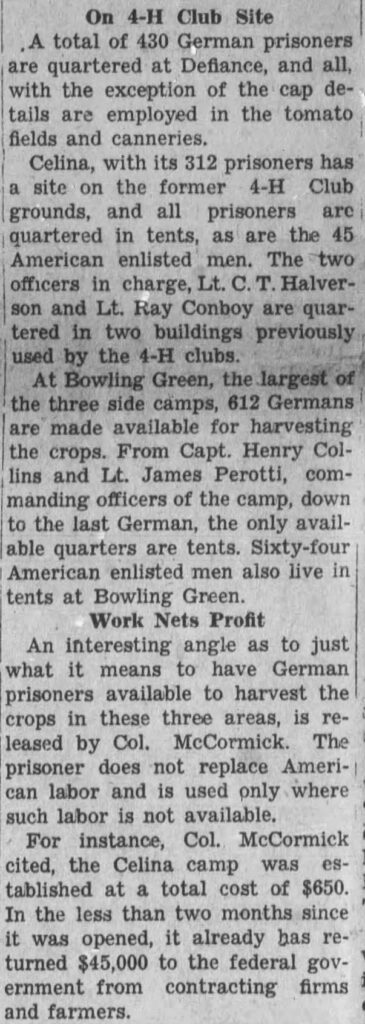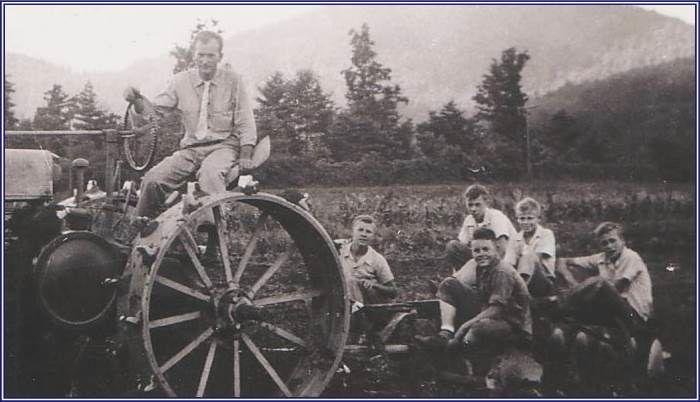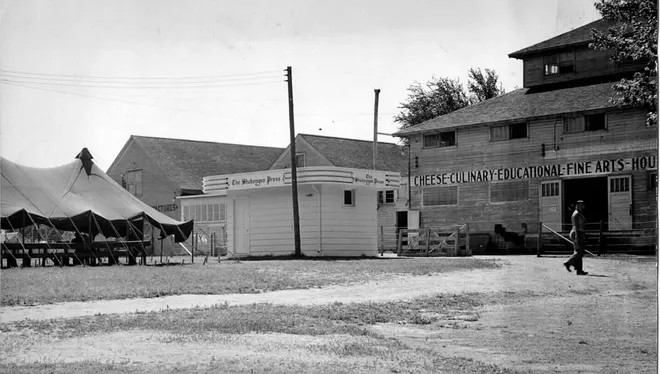As summer emerges young people at 4-H camps across the country might play basketball, take line dancing lessons, practice archery and roast marshmallows –all carefree summertime activities. However, during WWII, some of the same camps were used to house German prisoners of war. In this Footnote we will explore this little known history.
Harbor Point 4-H Camp (Celina, Ohio)
The Harbor Point 4-H Camp is located on Grand Lake in Celina, Ohio in Mercer County which borders Indiana. It is about 100 miles north and west of Columbus, Ohio. The camp buildings were probably part of a government work program during the great depression and were built in the 1930s. The land on which the camp is located was purchased by the county in May of 1936 for $1.
During World War II some 6,000 German Prisoners of War (POWs) were sent to Camp Perry near Port Clinton, Ohio. From there the prisoners were farmed out (pun intended) to nine branch camps in northwest Ohio. The hard-core prisoners remained at Camp Perry but the other prisoners, many teenagers, were sent to the branch camps including the Harbor Point 4-H Camp.

Figure 1. Location of the Harbor Point 4-H Camp
During World War II there was an acute shortage of farm labor because many of the men were overseas fighting. The government came up with the idea of having POWs work on farms. In the summer of 1944 294 POWs were sent to the Harbor Point 4-H Camp. Of the POWs sent to the 13 acre Harbor Point 4-H Camp, 291 were privates between the ages of 17 and 18.
The 4-H camp was surrounded by a high fence with guard towers. Four small buildings on the grounds served as the canteen, administrative office, chapel, and store. A large barrack served as the mess hall and kitchen. The POWs slept in 98 tents, 3 per tent. There was also a library and infirmary. The rest of the buildings at the camp were occupied by American soldiers.
Prisoners woke up at 6 a.m., ate breakfast at 6:30 a.m. and were transported to worksites at 7:30 a.m. They worked for eight hours before returning to the 4-H camp, where the lights were turned off at 9:30 p.m. The POWs picked tomatoes for canneries at various locations in the county. A newspaper article about the 4-H POW camp in Celina states that it cost $650 to outfit the camp but had returned $45,000 from contracts with farmers and businesses.

Figure 2. Article from the Port Clinton Herald and Register (September 22, 1944),
Barb Phares, Mercer Co. Extension Educator, in an interview said “It was really a great fit because Mercer County needed the manual labor that these young men could provide, and also many people spoke some German here in Mercer County so they could communicate.”
The prisoners received 80 cents a day for working. Most of the money was spent in the camp cafeteria, and prisoners had a fondness for menthol cigarettes and Coca-Cola. It was said you couldn’t keep enough Coca-Cola in the camp.
In mid-October, after the tomato harvest, the Celina camp prisoners were returned to Camp Perry. Some Ohio farmers wrote to the war department asking for the POWS to stay longer.
Swannanoa 4-H Camp (Black Mountain, North Carolina)
In 1928 twelve acres of land that was part of a branch agricultural experiment station near Asheville, NC was given to the 4-H for a camp. The camp opened for campers in 1929. It served as a 4-H camp until WWII when the camp was converted to a German prisoner of war camp. Prisoners with masonry and carpentry skills worked at camp building structures that still exist today. The 4-H camp was closed in 2013 because of budget cuts and is now the Black Mountain Home for Children.
In addition to working on camp facilities, the POWs probably performed agricultural chores at the adjacent agricultural experiment station and perhaps in the neighboring communities.
It was frustrating trying to locate information about the use of the Swannanoa 4-H Camp as a POW camp. According to Jenny Giles, a local historian in the area, this is because “the POW program was kept relatively secret.” The location of POW camps and activities of the prisoners were not widely known because local residents were concerned the prisoners might escape and there was animosity toward the German POWs when it was learned how American POWs were being treated by the Germans. Many Americans felt the German POWs were pampered. Giles and a local history teacher searched for photos of the POW camps in the area and “came up dry.”
A review of the book Nazi POWs in the Tar Heel State states “most people were – and remain – unaware of their presence.” I checked the book out of the NCSU library and found no mention of the Swannanoa 4-H Camp in the book. Likewise the history of 4-H in North Carolina, Clover All Over, doesn’t mention the camp as a POW camp either.

Figure 3. The Swannanoa Valley Museum has this photo of POWs from the Swannanoa 4-H camp but there is no additional information about it. Most of the POWs were 17-18 years of age. One captured German soldier was only 10 years of age.
Clyde York 4-H Center (Crossville, Tennessee)
The Clyde York 4-H Center in Tennessee housed German and Italian POWs but that was before it became a 4-H Camp. It originally was a Civilian Conservation Corp camp during the 1930s. During World War II it was converted into a POW camp and housed some of the more dangerous POWs. It was one of eleven POW camps in Tennessee.
Some of the prisoners were allowed to work outside of the camp. At one time 202 enlisted men and 160 officers were working on local farms. They worked on potato and vegetable farms in Cumberland and Fentress counties. The farmers paid the government $1.60 a day for POW labor with half of that going to the prisoners in the form of commissary coupons. One additional benefit of working was you got to eat at the “workers table” in camp which featured more substantive meals than nonworkers received.
The camp was open for three years and was closed on December 7, 1945. In 1949 steps were taken to convert the facility into a 4-H Camp. There is one remaining building from the POW days, “The Hospital” which is located near the Morgan/Jolley Friendship Circle.

Figure 4. The POW Hospital is now used for crafts at the Clyde York 4-H Center.
4-H Building, Plymouth, Wisconsin Fairgrounds
The 4-H Building at the fairgrounds in Plymouth, Wisconsin was used to house German POWs. There was an acute labor shortage in Wisconsin in 1944 and 1945. The POWs housed at the Plymouth fairgrounds worked at the Stokely plant in Plymouth and the Elkhart Lake and Waldo canning companies. They also helped harvest crops on area farms. The camp was open for three months in 1944 and 1945.

Figure 5. Most of the POWs were housed in the 4-H building at the right of the photo. The tent in the photo served as an open air mess during fair weather.
4-H Building, Fairmont, Martin County Minnesota Fairgrounds.
A notice sent to the Fairmont (MN) newspaper on September 5, 1944 stated “Faced with a critical labor shortage, Fairmont Canning Company and the United States Army have brought a group of German war prisoners to work in the Fairmont factory.” Approximately 50 POWs were the first to arrive in Fairmont (from the POW camp in Algona, Iowa) and they were housed in the 4-H Building at the fairgrounds.
The POWs worked at the canning factory and out in the neighboring fields. Some of the POWs also worked for the Pioneer and DeKalb seed companies. There were approximately 600 POWs housed in Fairmont between 1944 and 1945. At first guards accompanied the POW farm workers, however over time, they were entrusted to the care of farmers who brought them back to the fairgrounds at night.
Concluding Remarks
Burt wrote (1968, p. 136) “A lot of folks in Middle Tennessee didn’t even know the camp was there. In the interest of military security, very little had been said about it in the newspapers hereabouts.” I found this statement to be very true. The existence of POW camps was often a closely guarded secret. Finding information for this Footnote was a challenge.
Twenty years from now, if I were to write a Footnote about your organization, would I be able to find information about your activities? Typically agricultural educators are modest, and we don’t blow our own horns, but we should. We do great things for young people and other agriculturalists. We need to let the world know about what we do and document it. That is why most organizations have reporters and historians. Let’s start fully documenting what we do.
One thing I learned from writing this Footnote is that the POWs were typically treated humanely and with respect. Some former POWs even wrote books detailing their positive experiences in POW camps. After the war, some of the POWs returned to live in the United States in areas where they had been imprisoned and worked. Treating people fairly and humanly works no matter who they are.
References
Burt, Jesse (1968, April 14). Camp Crossville, Barbed Wire in the Scrub Oaks. The Tennessean.
Dippel, Beth (2016, April 29). In WWII, Sheboygan hosted German POWs. Sheboygan Press.
History Café Webinar: The Swannanoa 4-H Camp as German POW Camp in WWII. Swannanoa Valley Museum and History Center.
Kincaid, William (2020, May 23), County Held German POWs. The Daily Standard.
Martin County Historical Society (n.d.). POWs in Martin County.
